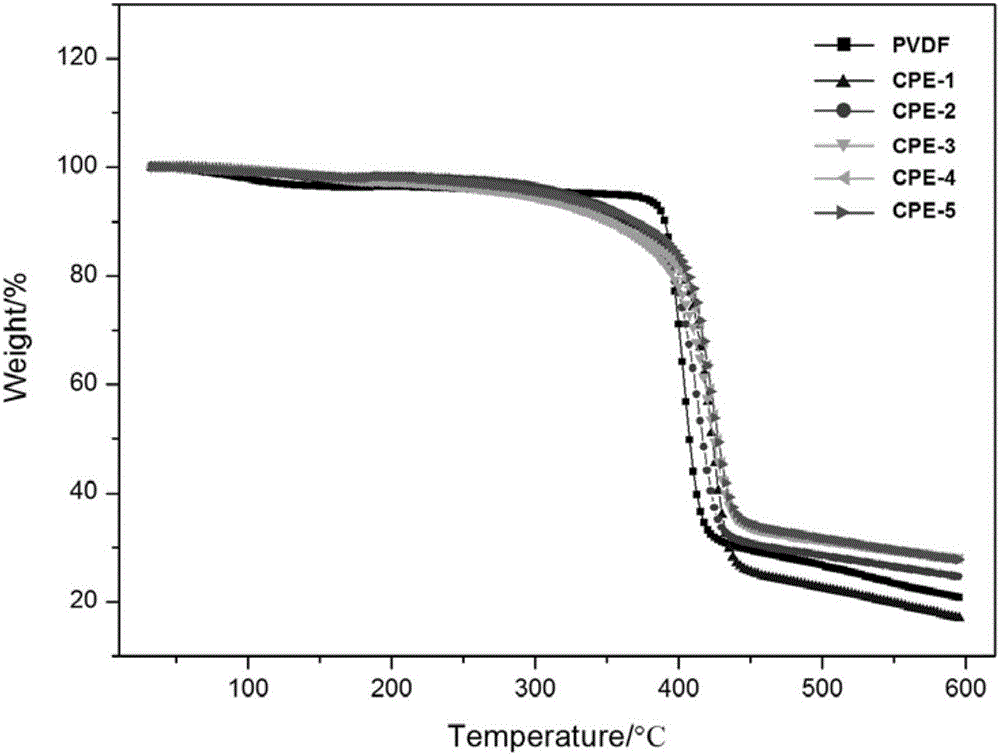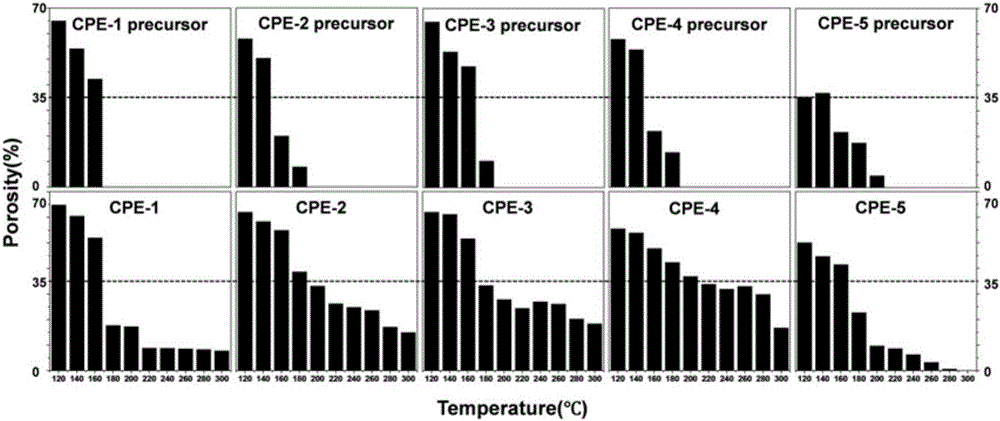Preparation method of gel electrolyte and gel electrolyte prepared with preparation method
A gel electrolyte, porous membrane technology, applied in the direction of electrolyte immobilization/gelation, circuits, electrical components, etc., can solve the problems of poor dimensional stability and poor thermal stability of gel electrolytes, and achieve the effect of good thermal stability
- Summary
- Abstract
- Description
- Claims
- Application Information
AI Technical Summary
Problems solved by technology
Method used
Image
Examples
Embodiment 1
[0048] in PS 15 -PEO-PS 15 Preparation of cross-linked porous membranes with three-stage copolymers.
[0049] a) In an anhydrous and oxygen-free environment, after mixing 150ml of dichloromethane and 8.8g of polyethylene oxide (Mn=8000g / mol) uniformly, 4.46ml of triethylamine was added thereto and mixed uniformly to obtain first mixture.
[0050] Under an anhydrous and oxygen-free environment, 10 mL of dichloromethane and 4.14 mL of 2-bromoisobutyryl bromide were uniformly mixed to obtain a second mixed solution.
[0051] At the temperature of the ice-water bath, the second mixed solution was added to the first mixed solution to obtain a reaction system, and the reaction system was stirred at 28° C. for 18 hours to obtain the first intermediate. The first intermediate was washed three times with a saturated sodium bicarbonate solution, and then washed three times with deionized water. Add an appropriate amount of anhydrous sodium sulfate to the washed first intermediate to...
Embodiment 2
[0057] in PS 25 -PEO-PS 25 Preparation of cross-linked porous membranes with three-stage copolymers.
[0058] a) In an anhydrous and oxygen-free environment, after mixing 150ml of dichloromethane and 8.8g of polyethylene oxide (Mn=8000g / mol) uniformly, 4.46ml of triethylamine was added thereto and mixed uniformly to obtain first mixture.
[0059] Under an anhydrous and oxygen-free environment, 10 mL of dichloromethane and 4.14 mL of 2-bromoisobutyryl bromide were uniformly mixed to obtain a second mixed solution.
[0060] At the temperature of the ice-water bath, the second mixed solution was added to the first mixed solution to obtain a reaction system, and the reaction system was stirred at a temperature of 30° C. for 16 hours to obtain the first intermediate. The first intermediate was washed three times with a saturated sodium bicarbonate solution, and then washed three times with deionized water. Add an appropriate amount of anhydrous sodium sulfate to the washed firs...
Embodiment 3
[0066] in PS 50 -PEO-PS 50 Preparation of cross-linked porous membranes with three-stage copolymers.
[0067] a) In an anhydrous and oxygen-free environment, after mixing 150ml of dichloromethane and 8.8g of polyethylene oxide (Mn=8000g / mol) uniformly, 4.46ml of triethylamine was added thereto and mixed uniformly to obtain first mixture.
[0068] Under an anhydrous and oxygen-free environment, 10 mL of dichloromethane and 4.14 mL of 2-bromoisobutyryl bromide were uniformly mixed to obtain a second mixed solution.
[0069] At the temperature of the ice-water bath, the second mixed solution was added to the first mixed solution to obtain a reaction system, and the reaction system was stirred at 25° C. for 20 h to obtain the first intermediate. The first intermediate was washed three times with a saturated sodium bicarbonate solution, and then washed three times with deionized water. Add an appropriate amount of anhydrous sodium sulfate to the washed first intermediate to dry...
PUM
| Property | Measurement | Unit |
|---|---|---|
| Ionic conductivity | aaaaa | aaaaa |
Abstract
Description
Claims
Application Information
 Login to View More
Login to View More - R&D
- Intellectual Property
- Life Sciences
- Materials
- Tech Scout
- Unparalleled Data Quality
- Higher Quality Content
- 60% Fewer Hallucinations
Browse by: Latest US Patents, China's latest patents, Technical Efficacy Thesaurus, Application Domain, Technology Topic, Popular Technical Reports.
© 2025 PatSnap. All rights reserved.Legal|Privacy policy|Modern Slavery Act Transparency Statement|Sitemap|About US| Contact US: help@patsnap.com



